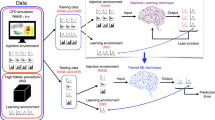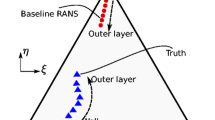Abstract
High fidelity computational fluid dynamics (CFD) is increasingly being used to enable deeper understanding of turbulence or to aid in the design of practical engineering systems. While such CFD approaches can predict complex turbulence phenomena, the computational grid often needs to be sufficiently refined to accurately capture the flow, especially at high Reynolds number. As a result, the computational cost of the CFD can become very high. It therefore becomes impractical to adopt such simulations for parametric investigations. To mitigate this, we propose a framework where coarse grid simulations can be used to predict the fine grid results through machine learning. Coarsening the computational grid increases the grid-induced error and affects the prediction of turbulence. This requires an approach that can generate a data-driven surrogate model capable of predicting the local error distribution and correcting for the turbulence quantities. The proposed framework is tested using a turbulent bluff-body flow in an enclosed duct. We first highlight the flow field differences between the fine grid and coarse grid simulations. We then consider a set of scenarios to investigate the capability of the surrogate model to interpolate and extrapolate outside the training data range. The impact of operating conditions and grid sizes are considered. A Random Forest regression algorithm is used to construct the surrogate model. Two different sets of input features are investigated. The first only takes into account the grid-induced error and local flow properties. The second supplements the first using additional variables that serve to capture and generalise turbulence. The global and localised errors for the predictions are quantified. We show that the second set of input features is better at correcting for the biases due to insufficient resolution and spurious flow behaviour, providing more accurate and consistent predictions. The proposed method has proven to be capable of correcting the coarse-grid results and obtaining reasonable predictions for new, unseen cases. Based on the investigated cases, we found this method maximises the benefit of the available data and shows potential for a good predictive capability.















Similar content being viewed by others
References
Ahmed, S.R., Ramm, G., Faltin, G.: Some salient features of the time-averaged ground vehicle wake. Technical report SAE technical paper, p. 840300 (1984)
Balasubramanian, A.G., Gastonia, L., Schlatter, P, Azizpour, H., Vinuesa, R.: Predicting the wall-shear stress and wall pressure through convolutional neural networks, arXiv:2303.00706 (2023)
Blocken, B.: LES over RANS in building simulation for outdoor and indoor applications: a foregone conclusion? Build. Simul. 11, 821–870 (2018)
Bose, S.T., Moin, P., You, D.: Grid-independent large-eddy simulation using explicit filtering. Phys. Fluids 22, 1–6 (2010)
Breiman, L.: Random forests. Mach. Learn. 45, 5–32 (2001)
Breiman, L., Friedman, J.H., Stone, C.J., Olshen, R.A.: Classification and Regression Trees, 1st edn. Taylors and Francis, Boca Raton, FL (1984)
Brunton, S.L., Noack, B.R., Koumoutsakos, P.: Machine learning for fluid mechanics. Annu. Rev. Fluid Mech. 52, 477–508 (2019)
Cocks, P.A.T., Soteriou, M.C., Sankaran, V.: Impact of numerics on the predictive capabilities of reacting flow LES. Comb. Flame 162, 3394–3411 (2015)
Craft, T.J., Launder, B.E., Suga, K.: Development and application of a cubic eddy-viscosity model of turbulence. Int. J. Heat Fluid Flow 17, 108–115 (1996)
Cremades, A., Hoyas, S., Quintero, P., Lellep, M., Linkmann, M., Vinuesa, R.: Explaining wall-bounded turbulence through deep learning, arXiv:2302.01250 (2023)
Duraisamy, K., Iaccarino, G., Xiao, H.: Turbulence modeling in the age of data. Annu. Rev. Fluid Mech. 51, 357–377 (2019)
Efron, B., Tibshirani, R.J.: An Introduction to the Bootstrap, Boca Raton, 1st edn. CRC Press, New York (1993)
Freitag, M., Klein, M.: An improved method to assess the quality of large eddy simulations in the context of implicit filtering. J. Turb. 7, N40 (2006)
Fureby, C.: A computational study of combustion instabilities due to vortex shedding. Proc. Comb. Inst. 28, 783–791 (2000)
Fureby, C., Löfström, C.: Large-eddy simulations of bluff body stabilized flames, Symp. (Int.) on Comb. 25, 1257–1264 (1994)
Guastoni, L., Encinar, M.P., Schlatter, P., Azizpour, H., Vinuesa, R.: Prediction of wall-bounded turbulence from wall quantities using convolutional neural networks, J. Phys.: Conf. Ser, 1522, p. 12022 (2020)
Hanna, B.N., Dinh, N.T., Youngblood, R.W., Bolotnov, I.A.: Machine-learning based error prediction approach for coarse-grid computational fluid dynamics (CG-CFD). Prog. Nucl. Energy 118, 1–14 (2020)
Hunt, J.C.R., Savill, A.M.: Chapter 8—Guidelines and criteria for the use of turbulence models in complex flows, In: Vassilicos, J.C. (eds) Predictions of Turbulent Flows (2005)
Issa, R.I.: Solution of the implicitly discretised fluid flow equations by operator-splitting. J. Comput. Phys. 62, 40–65 (1985)
Jarrin, N., Benhamadouche, S., Laurence, D., Prosser, R.: A synthetic-eddy-method for generating Inflow conditions for large-eddy simulations. Int. J. Heat Fluid Flow 27, 585–593 (2006)
Jones, W.P., Marquis, A.J., Wang, F.: Large eddy simulation of a premixed propane turbulent bluff body flame using the Eulerian stochastic field method. Fuel 140, 514–525 (2015)
Kaandorp, M.L., Dwight, R.P.: Data-driven modelling of the Reynolds stress tensor using random forests with invariance. Comp. Fluids 202, 1–16 (2020)
Klein, M.: An attempt to assess the quality of large eddy simulations in the context of implicit filtering. Flow Turb. Combust. 75, 131–147 (2005)
Kurz, M., Offenhauser, P., Viola, D., Resch, M., Beck, A.: Relexi—a scalable open source reinforcement learning framework for high-performance computing. Software Impacts 14, p. 100422 (2022)
Kutz, J.N.: Deep learning in fluid dynamics. J. Fluid Mech. 814, 1–4 (2017)
Lee, C.Y., Cant, S.: Large-eddy simulation of a bluff-body stabilised turbulent premixed flame using the transported flame surface density approach. Comb. Theory Model. 21, 722–748 (2017)
Ling, J., Templeton, J.: Evaluation of machine learning algorithms for prediction of regions of high Reynolds averaged Navier Stokes uncertainty. Phys. Fluids 27, 1–8 (2015)
Ling, J., Kurzawski, A., Templeton, J.: Reynolds averaged turbulence modelling using deep neural networks with embedded invariance. J. Fluid Mech. 807, 155–166 (2016)
Mehta, D., van Zuijlen, A.H., Koren, B., Holierhoek, J.G., Bijl, H.: Large eddy simulation of wind farm aerodynamics: a review. J. Wind Eng. Ind. Aerodyn. 133, 1–17 (2014)
Milano, M., Koumoutsakos, P.: Neural network modeling for near wall turbulent flow. J. Comp. Phys. 182, 1–26 (2002)
Moin, P., Mahesh, K.: Direct numerical simulation: a tool in turbulence research. Annu. Rev. Fluid Mech. 30, 539–578 (1998)
Oshiro, T.M., Perez, P.S., Baranauskas, J.A.: How many trees in a random forest?. In: 8th International Conference on Machine Learning and Data Mining in Pattern Recognition, Lecture notes in computer science, 7376, Springer, Berlin, Germany (2012)
Pedregosa, F., Varoquaux, G., Gramfort, A., Michel, V., Thirion, B., Grisel, O., Blondel, M., Prettenhofer, P., Weiss, R., Dubourg, V., Vanderplas, J., Passos, A., Cournapeau, D., Brucher, M., Perrot, M., Duchesnay, E.: Scikit-learn: machine learning in python. J. Mach. Learn. Res. 12, 2825–2830 (2011)
Pitsch, H.: Large-eddy simulation of turbulent combustion. Annu. Rev. Fluid Mech. 38, 453–482 (2006)
Pope, S.B.: Turbulent flows, Cambridge University Press, (2000)
Sagaut, P.: Large Eddy Simulation for Incompressible Flows. Springer, Berlin, Heidelberg (2006)
Shanbhogue, S.J., Husain, S., Lieuwen, T.C.: Lean blowoff of bluff body stabilized flames: scaling and dynamics. Prog. Energy Combust. Sci. 35, 98–120 (2009)
Singh, A.P., Matai, R., Mishra, A., Duraisamy, K., Durbin, P.A.: Data-driven augmentation of turbulence models for adverse pressure gradient flows, In: 23nd AIAA Computational Fluid Dynamics Conference, Denver, Colorado, AIAA 2017, 3626 (2017)
Sjunnesson, A., Olovsson, S., Sjöblom, S.: Validation rig—a tool for flame studies. In: ISABE Conference, Nottingham, UK (1991a)
Sjunnesson, A., Olovsson, S., Max, E.: Measurements of velocities and turbulence in a bluff body stabilized flame. In: Fourth International Conference on Laser Anemometry—Advances and Application, ASME Cleveland, US (1991b)
Sjunnesson, A., Henrikson P., Löfström C.: CARS measurement and visualization of reacting flow in a bluff body stabilized flame. AIAA/SAE/ASME/ASEE 28th Joint Propulsion Conference and Exhibit, July 6–8, Nashville, TN (1992)
Smagorinsky, J. : General circulation experiments with the primitive equations: I. The basic experiment, Mon. Weather Rev. 91, 99–165 (1963)
Svetnik, V., Liaw, A., Tong, C., Culberson, J.C., Sheridan, R.P., Feuston, B.P.: Random forest: a classification and regression tool for compound classification and QSAR modeling. J. Chem. Inf. Comput. Sci. 43, 1947–1958 (2003)
Svetnik, V., Liaw, A., Tong, C.: Variable selection in random forest with application to quantitative structure–activity relationship, Proceedings of the 7th Course on Ensemble Methods for Learning Machines (2004)
Tani, I.: Low-speed flows involving bubble separations. Prog. Aerosp. Sci. 5, 70–103 (1964)
Tracey, B., Duraisamy, K., Alonso, J.: A machine learning strategy to assist turbulence model development, In: 53rd AIAA Aerospace Sciences Meeting, Kissimmee, Florida, AIAA 2015, 1287 (2013)
Tsang, C.-W., Trujillo, M.F., Rutland, C.J.: Large-eddy simulation of shear flows and high-speed vaporizing liquid fuel sprays. Comp. Fluids 105, 262–279 (2014)
Tucker, P.G.: Trends in turbomachinery turbulence treatments. Prog. Aerosp. Sci. 63, 1–32 (2013)
Weller, H.G., Tabor, G.R., Jasak, H., Fureby, C.: A tensorial approach to computational continuum mechanics using object-oriented techniques. J. Comput. Phys. 12, 620–631 (1998)
Wolpert, D.H.: The lack of a priori distinctions between learning algorithms. Neural Comput. 8, 1341–1390 (1996)
Wu, J.-L., Xiao, H., Paterson, E.: Physics-informed machine learning approach for augmenting turbulence models: a comprehensive framework. Phys. Rev. Fluids 3, 1–42 (2018)
You, D., Wang, M., Moin, P., Mittal, R.: Large-eddy simulation analysis of mechanisms for viscous losses in a turbomachinery tip-clearance flow. J. Fluid Mech. 586, 177–204 (2007)
Zhang, Z.J., Duraisamy, K.: Machine learning methods for data-driven turbulence modeling. In: 22nd AIAA Computational Fluid Dynamics Conference, Dallas, TX, AIAA 2015, 2460 (2015)
Acknowledgements
The authors would like to acknowledge the useful feedback and valuable advice provided by Prof. Matthew Juniper and Dr. Botros Hanna.
Funding
No funding was received for conducting this study.
Author information
Authors and Affiliations
Contributions
CYL—conducted the research, prepared the results and wrote the main manuscript. SC—reviewed the manuscript and provided recommendations.
Corresponding author
Ethics declarations
Conflict of interest
The authors have no competing interest to declare that are relevant to the content of the article.
Ethical Approval
Not applicable. The article does not contain any studies on human and animal subjects.
Informed Consent
Not applicable.
Rights and permissions
Springer Nature or its licensor (e.g. a society or other partner) holds exclusive rights to this article under a publishing agreement with the author(s) or other rightsholder(s); author self-archiving of the accepted manuscript version of this article is solely governed by the terms of such publishing agreement and applicable law.
About this article
Cite this article
Lee, C.Y., Cant, S. A Grid-Induced and Physics-Informed Machine Learning CFD Framework for Turbulent Flows. Flow Turbulence Combust 112, 407–442 (2024). https://doi.org/10.1007/s10494-023-00506-2
Received:
Accepted:
Published:
Issue Date:
DOI: https://doi.org/10.1007/s10494-023-00506-2




